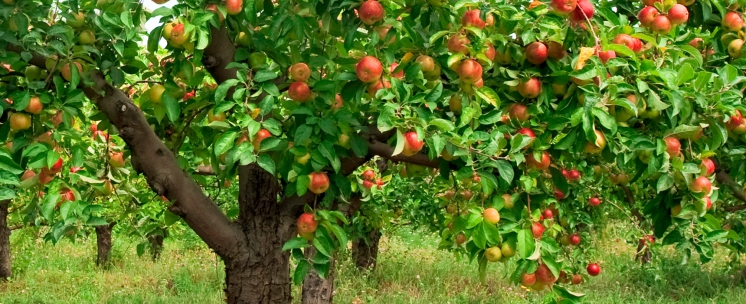The SIR Program and the Regional District or Municipal Noxious Insect Bylaws are in place to protect our agricultural community. Fruit-growers can suffer economic losses caused by invasive pests. Codling moths can migrate from neglected backyard fruit trees into commercial orchards destroying fruit. If pest populations increase, orchards will require additional pest management strategies (which can include more pesticide application).
-
Letters & Notices
Banding/Debanding Letter/NoticeIn 2015, SIR changed from a letter to a door hanger which is left at the residence after an SIR Field Staff person has placed single-face corrugated cardboard banding on the codling moth host tree(s) located on the property.
It informs the resident of what the banding is, why it’s put on their tree, and other methods of codling moth control that can be implemented. When the larvae exit the fruit and search for a place to pupate/overwinter, roughly 30 to 40% of them will end up in the banding instead of the tree bark. This tells us the possible level of infestation for the tree.
In the fall we remove the bands and leave a debanding notice with the number of larvae found (overwintering larvae, and signs of those from earlier brood that pupated), and whether or not a sample is attached. If a large number of larvae are found, this may lead to a Schedule B Codling Moth Control Order letter being sent the following year.
-
Care of Trees Letter (Hot Letter)
These letters are sent out in April and have the title “CARE OF APPLE, PEAR, CRABAPPLE & QUINCE TREES”.
Tree Care letters are sent out to make sure the property owner is aware that a property they own with codling moth host trees has, has had, or is at risk of having unacceptable levels of codling moth infestation.
The recipients of a Tree Care Letter are NOT REQUIRED to strip the fruit from their trees. This is merely a suggestion so that they may help prevent further or future infestation. Other control methods are suggested as well – it is best to use a combination of these methods to increase the chance of successful control.
A picture of a hard pruned tree is included on the back of this form letter as an example of the best way to remove most of the fruit quickly and easily should the owner choose to do so.
-
Schedule B - Codling Moth Control Order
These letters are printed and sent out in April to property owners that are required to remove all fruit from their codling moth host trees by June 1 of the current year.
In this case, fruit removal is not merely a suggestion – it is a legal order. The trees that require this action (whether all or only some) are listed on the order. Pruning the tree and opening up the canopy is a good way to remove some of the fruit, and then the remaining buds will need to be removed as well. The buds are easier to find when the petals are in bloom, but the bud itself needs to be removed – not just the petals. Hard pruning the tree will remove the most fruit and make it easier to remove it the next year as well.
Codling moths need the fruit in order to complete their lifecycle – this is why stripping the fruit is such an effective method for codling moth control. Even when the moths emerge from overwintering and mate and lay eggs, if the larvae have nothing to feed on then they will starve. Stripping is usually required for at least a couple of years, as some larvae may remain dormant for an extra year or two.
During re-inspection, if we find that the resident has not stripped the required tree(s) then a reminder will be given. If the resident refuses to comply then SIR will be required to strip the fruit for them at a rate of $50 per man hour (as set by the Board) and also possible charges for disposing of the fruit – infested fruit must be properly disposed of.
If the fruit is stripped too late or apples are missed then there is higher risk of infestation continuing. Those that strip their fruit completely and by/before the required deadline are more likely to go back to growing fruit sooner than those that don’t (because those that don’t are at higher risk for continued infestation).
This order can not be appealed.
-
Schedule A - Warning Notice
Property owners can receive this warning notice at any time if a codling moth infestation has been found on your property. This letter requires property owners to remove all fruit from their codling moth host trees.
This is like a Schedule B as it requires the grower to strip the fruit from their host trees; however, this strip order is issued by staff if they determine in the middle of the season that a tree has too high a level of infestation. Growers are given roughly a week or so to have all of the fruit removed from the tree(s).
-
Schedule D - Codling Moth Host Tree Removal Order
This is a tree removal order – the last option. It is a priority to work with owners to prevent and remove codling moth infestation, but if there is an unacceptable history of codling moth infestation and it seems that the trees will continue to remain in such a state, then this order, and a legal package, may be issued by a Compliance Officer. The schedule is usually delivered in person so that we know that they have received it. Once the schedule is issued, the owner has a week to either remove the tree(s) as ordered or make an appeal.
If the owner chooses to appeal the tree removal order, then they will need to fill out and return to us an Appeal Letter – Schedule F within seven days. They will then be invited to appear before the SIR board to present their appeal. The board will then decide whether or not the tree(s) will be removed.

